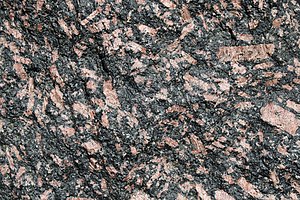Alkali feldspar granite
Alkali feldspar granite is an igneous alkali rock that belongs to the granite group (granitoids).

definition

The decisive factor for the petrological definition of alkali feldspar granite is the mixture of plagioclase , which must not be more than 10 percent by volume. It should be noted that the proportion of the plagioclase albite is included in the alkali feldspar. The quartz content can vary between 20 and 60 percent by volume. According to Albert Fahrtisen (1973), alkali feldspar granites are therefore in QAPF field 2.
Mineral inventory
The alkali feldspar granite has the highest SiO 2 content of all plutonites . Alkali feldspars (hence the name of the rock) and quartz are the dominant components. While the alkali feldspars make up 90 to 100 percent of all feldspars, plagioclases are usually less than 10 percent involved, and they are often completely absent. On the other hand, there are alkali feldspar granites with a content of up to 40 percent albite , the feldspar mineral formally counted as plagioclase, which is also the richest in sodium in the mixture of alkali feldspars. Mica minerals , mostly biotite and muscovite , are also found in smaller quantities . Other minerals such as hornblende , andalusite , garnet , cordierite and sillimanite are generally very low.
If the rock is more darker than 20 percent by volume, melanokrater contain minerals, this is the prefix melamine indicated: Mela-Alkalifeldspatgranit .
Varieties
Alkali granite
The term alkali granite was first introduced into the specialist literature in 1896 by Karl Heinrich Rosenbusch . It refers to a peralkaline granite that contains alkali amphibole and alkali pyroxene . According to the IUGS, however, using this rock name synonymously with alkali feldspar granite should be avoided.
Alaskit
Alaskites are leucocrate alkali feldspar granites in which light-colored minerals such as quartz and alkali feldspar occur almost exclusively.
Luxullianite
If tourmaline suns appear in alkali feldspar granites, it is referred to as a luxullianite .
Tarantulite
With a proportion of more than 50 percent quartz in alkali feldspar granites, the rock is called tarantulite .
Origin and occurrence

The conditions of formation and distribution are largely similar to those of granites, but alkali feldspar granites are formed from extremely acidic (silica-rich) magmas and are therefore much less common than granites containing plagioclase. They are often associated with granites and are found in granite bodies ( plutons ), especially in their edge and roof areas. Alkali feldspar granites usually crystallize out like granites, when the remaining magma is already depleted of more basic components. Alkali feldspar granites often show transitions to pegmatites .
In Europe, the most important mineable deposits of alkali feldspar granites are found in Scandinavia .
Rock description
The alkali feldspar granites are fine to coarse-grained. They do not differ in their grain size from granite. The color of the alkali feldspar granites is usually based on that of the potash feldspars. Mostly there are reddish tones, which can go up to strong flesh-red colors. But light, almost white-looking alkali feldspar granites also occur. The red color is caused by hematite .
use
The alkali feldspar granites are used because of their high resistance, hardness and weather resistance and because of their good grindability and polishability in construction. They are used as exterior wall cladding, stair and floor coverings, window sills, table tops, kitchen worktops and washbasins . They are also used in granite sculpture, provided they are fine to medium-grained.
Alkali feldspar granites are coveted building and decorative stones because of their often strong and uniform color. Similar to granodiorite , alkali feldspar granite is usually referred to as granite in everyday language.
Types of natural stone
A selection:
- Balmoral Fein and Balmoral Grob , Vehmaa in Finland
- Tranås Rubin , Gotland in Sweden
- Meissen granite , Meissen in Saxony
- Gotenrot , near Uppsala in Sweden
literature
- Walter Maresch, Olaf Medenbach: Steinbach's natural guide. Rocks. Mosaik-Verlag, Munich 1996, ISBN 3-576-10699-5 .
- Walter Maresch, Hans-Peter Schertl, Olaf Medenbach: Rocks. Systematics, determination, origin. 2., completely reworked. Edition. Schweizerbart, Stuttgart 2014, ISBN 978-3-510-65285-3 .
- Dietmar Reinsch: Geology. In: Educational center for the stonemasonry and sculpture trade (Ed.): Steinmetzpraxis. The manual for daily work with natural stone. 2., revised. Edition. Ebner Verlag, Ulm 1994, ISBN 3-87188-139-2 .
Individual evidence
- ^ A. Fahrtisen: Plutonic rocks. Classification and nomenclature recommended by the IUGS Subcommission on the Systematics of Igneous Rocks . In: Geotimes . tape 18 (10) , 1973, pp. 26-30 .
- ^ W. Maresch, O. Medenbach: Steinbach's natural guide. 1996, p. 40.
- ↑ H. Rosenbusch: Microscopic Physiography of Minerals and Rocks . Vol. 2: Massive rocks . 3. Edition. Swiss beard, Stuttgart 1896, p. 1360 .
- ↑ D. Reinsch: Geology. 1994, p. 223.

